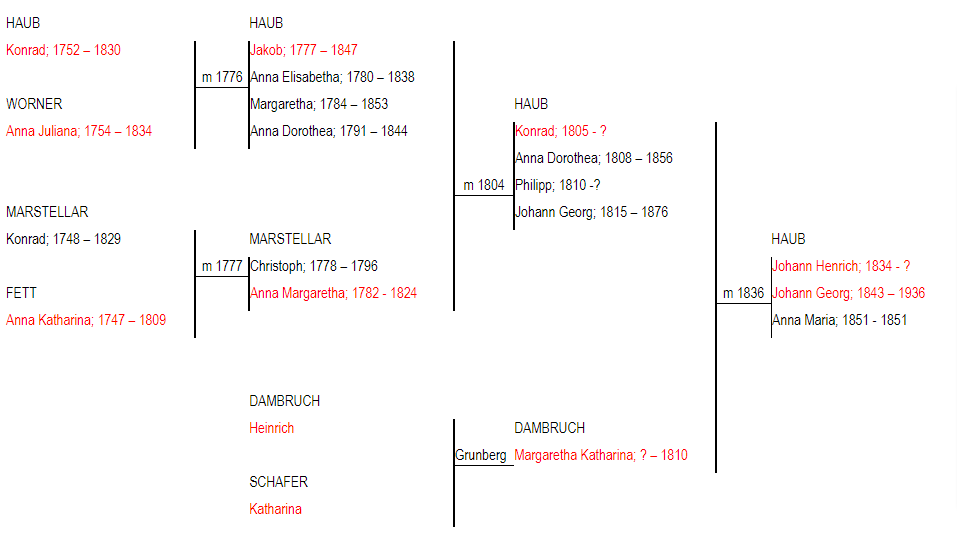Johann Georg HAUB 1843-1936
Johann Henrich born 1834 and Johann Georg born 19th March 1843 were the only sons of Konrad Haub III; a younger sister died when she was 2O weeks old. Konrad’s mother, Anna Margaretha Marsteller, was the last person to be born in Nieder-Weisel with that natal surname. Konrad’s father was from a branch of the family that had served in administrative posts for a number of generations but, like many others, they now had a much lower status in the changed village. Konrad married in 1836 the daughter of a tailor in the Grunberg parish, Maria Katharina Dambruch.
The details of the journey of Johann Georg Haub to Victoria are obscure, to say the least. His application for Letters of Naturalisation (granted on July 1885) states that he reached Melbourne on 16th January 1855 aboard the sailing ship “Truro”; there was no such arrival. In any case, Johann Georg was in Nieder-Weisel in May 1857 when he was confirmed, as was the custom, in his fourteenth year. His brother Johann Henrich was on “Dorothea” which arrived in September 1857 but there is no evidence that Johann Georg was with him. The ship “Turon” arrived on 3th January 1858 with several Germans on board, including two Schneiders, two Wetz, a Bill, a Klapper, a Klein, three Ludwigs, two Mullers and two “Hunters” – it could be that one of the latter, aged 15, was Johann Georg Haub.
George, as he decided to be known, spent about six years on the gold-fields of Central Victoria, probably going then to the Beechworth area in north-east Victoria with some of the other Nieder-Weiselerns. He then spent about five years in New South Wales, probably on the diggings at Lambing Flats, before returning to Victoria in about 187O. His prospecting must have been reasonably successful as he was able to buy the horses and vehicles needed to go into business as a cab proprietor in the Melbourne suburbs.
On 31st January 1872 George married the 19 year old daughter of a stonemason, Margaretha Theisz; the ceremony was held in the Lutheran German Church in Melbourne. Margaretha was born in Hull, where her parents, Henrich Theisz and Margaretha nee Fatum, had emigrated from their village of Lindensruth; the family came to Victoria in June 1857 on board “Crimea”. The Theisz family lived at 3O Rose St Fitzroy – only two blocks from George’s residence at 32 Argyle Street. For his best man, George chose Konrad Hildebrand from Nieder-Weisel, husband of Margaretha’s sister, Elisabetha; he was a coach driver.
Margaretha gave birth to their first son, Conrad George, in 1872. George’s business interests included a dairy farm at Arthur’s Creek, near Yan Yean north of Melbourne, and their second son, John Jacob, was born there in 1874. A daughter, Theresa, was born in Fitzroy in 1877, followed by Margaret Catherine at Arthur’s Creek in 1878. George now combined a milk delivery run in Clifton Hill with his dairy farming at Yan Yean. The third son, William, was born in their Clifton Hill home in 1885; he lived only a couple of months. George was now a naturalised citizen; he called himself a dairyman and spent his time between the dairy farm at Arthur’s Creek and the dairy at Clifton Hill. His last three children were born at Clifton Hill: Mary Maud in 1885, Edith May in 1889, and Florence Rose in 189O; the Haub home was then in Grant Street.
George spent over half a century as a citizen of his chosen country; he voted in the referendum which brought about the federation of the states in 19O1. He continued to operate a dairy at 2 Spensley Street Clifton Hill until well into his 60s. His son Conrad married into the Whelan family from Arthur’s Creek and became a fruit-grower, with a fruit shop in Clifton Hill. Several of his daughters married also, and George and Margaret were able to watch the next generation growing to adulthood as they moved into their 7Os and 8Os.
Johann Georg Haub lived into his 94th year; he died in his Clifton Hill home in 1936.
View Johann Georg's Family Chart

